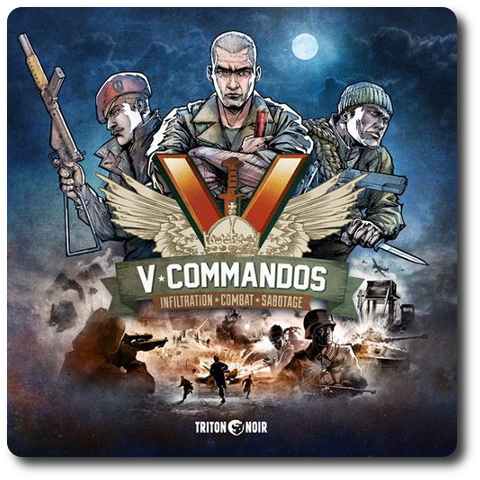
The Basics:
- For ages 14 and up
- For 1 to 4 players
- Variable game play length
Geek Skills:
- Active Listening & Communication
- Counting & Math
- Logical & Critical Decision Making
- Reading
- Strategy & Tactics
- Risk vs. Reward
- Visuospatial Skills
- Cooperative & Team Play
- Hand/Resource Management
Learning Curve:
- Child – Moderate
- Adult – Easy
Theme & Narrative:
- Fight for your country against incredible odds, the bad kind
Endorsements:
- Gamer Geek approved!
- Parent Geek mixed!
- Child Geek mixed!
Overview
American martial artist, actor, film producer and screenwriter, Chuck Norris, said “In times of conflict, our citizens have always been able to rise to the challenge. Maybe no greater example of that ability is found during the onset of World War II.” World War II is now romanticized as a time of great heroism, full of colorful characters, and brave acts. Which of course it was, but the horror of the “Second Great War” has been lost as the generation who fought it leave us. In this game, players take on the roles of brave soldiers from different countries who must work together against terrible odds. It might be just a game, but sacrifice and duty for a greater good is the premise.
V-Commandos, designed by Thibaud de la Touanne and published by Triton Noir, is comprised of 1 Training manual, 19 Indoor/Outside tiles (in various sizes), 1 Compass tile, 37 Event cards, 9 operation cards (paired), 26 Terrain cards, 5 Commando cards, 5 Commando tokens (stealthy/visible), 5 Commando tokens (German uniform/critical condition), 38 Regular Enemy Unit tokens, 14 Action tokens, 76 Equipment tokens, 7 “No Enemy” tokens, 4 Escort Character tokens, 10 Special Enemy Unit tokens, 2 MG42 Nest tokens, 20 Door tokens (open/shut), 8 Enemy Entrance tokens, 6 Trap Door tokens (open/shut), 2 Alarm tokens (silent/triggered), 6 Objective tokens, and 12 custom six-sided dice. The component quality is simply excellent. Even the rule book is of high quality. The artists, Vincent Filipiak and Bruno Tatti, flex their talents to make every component of this game dripping with theme which only serves to strengthen the game’s narrative.
Recon
To set up the game, have players first determine what operation (scenario) they would like to play. This is somewhat determined by the number of players in the game and the amount of time available. Each operation is comprised of at least three cards. These are the paired Operation cards and at least one or more Terrain cards. The Operation cards display the number of players needed and the estimated amount of time necessary to complete the game. The Operation cards also provide some thematic background and special rules.
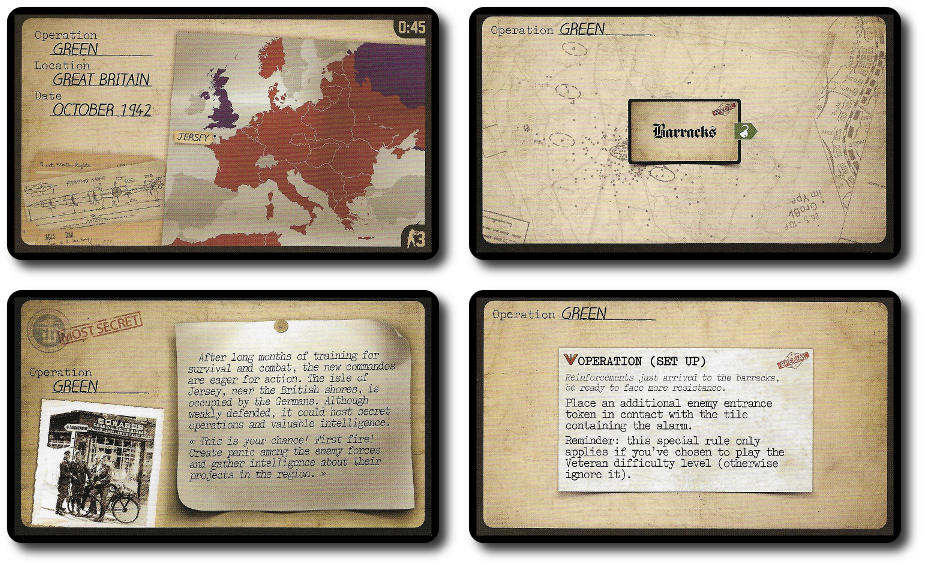
Second, the players create the terrain by building what is shown on the Terrain cards associated with the operation the players selected. Each Terrain card lists the number of tokens (by type) that are needed, the layout of Indoor/Outdoor tiles, and token placement. The Terrain card also lists the objective, which defines what must be accomplished before the terrain is considered “complete”. This is needed for operations that have several terrains in play at one time, as some terrains are “locked” until certain conditions are met. Place the Compass tile last and anywhere near the Terrain tiles.
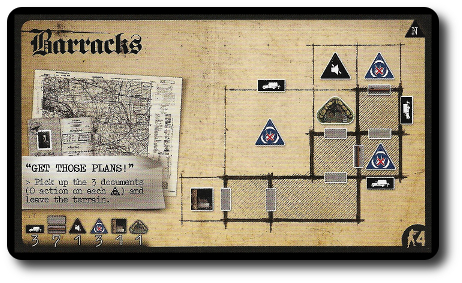
Third, the starting Enemy tokens are added to the Terrain tiles. The default is one Regular Enemy token per Terrain tile that has an Objective token. This can be changed per the players’ discretion or if playing the game in a more challenging mode.
Fourth, the Event cards are collected and shuffled to create the Event deck. The Event deck is placed face-down to one side of the game playing area.
Fifth, place the Equipment tokens and Enemy tokens in two separate bags. These bags will be used to draw from during the game to randomly produce enemies and miscellaneous equipment that is dropped and can later be collected. Three Special Enemy Unit tokens are added with the Regular Enemy tokens, as are the “No Enemy” tokens. The remaining Special Enemy tokens are set aside.
Fifth, have players select their starting Commando and collect the starting equipment tokens that each has on them. Each Commando has a unique approach to solving problems, but are all bad asses. The Commando cards are double-sided, allowing players to subtly shift their starting equipment. Any starting equipment listed on the Commando card should be found and the matching Equipment token placed in the designated spot.
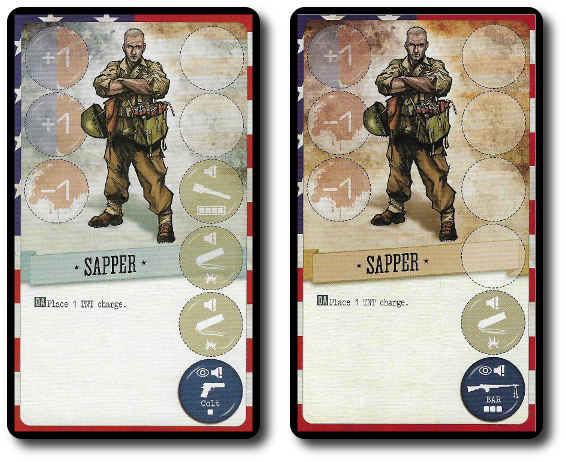
Sixth, place the remaining game components to one side, except for the unused Terrain cards, Operation cards, and Terrain tiles which can be put back in the box.
That’s it for game set up. Time to be heroes.
Mission: Semi-Impossible
V-Commandos is played in turns and steps. A typical game turn is summarized here. This is a cooperative game, meaning the players are working together to achieve an objective. Not all Commandos will survive and the players are not forced to work together at the same time. In fact, players will need to split their forces, working on several objective simultaneously, breaking into smaller teams. This is not only necessary to achieve objectives, but also to ensure the Commandos can remain under the enemy’s radar. Depending on the number of Commandos located in a certain terrain, the enemy alarms will be triggered automatically, greatly reducing the odds of the players being successful and the Commandos surviving.
Step One: Event
At the start of each round, an Event card is drawn for each terrain currently in play (where “terrain” is the name used for a collection of Terrain tiles that represent a location). These Event cards change the rules of the terrain they are associated with immediately, but only for the turn. Previously played Event cards are discarded. Event cards also determine in which direction (North, South, East, or West) the Enemy tokens will move during the round.
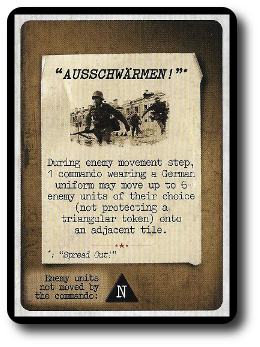
Step Two: The Commandos Act
The players now determine in which order they want their Commandos to act. When it’s the player’s turn during this step, they have a number of Action Points they can spend to move in and manipulate objects in the terrain. Some actions (dropping equipment and blowing up TNT) takes no Action Points, while others can take one (using equipment, attacking, or moving normally) or two (moving stealthily) or more (depending on the object being interacted with). Players can also reserve an Action Point, which costs an Action Point, but gives the player an additional action during their next turn.
While most of the actions are straight forward (attack, move, etc.), what needs a bit more explanation is moving stealthy. Stealth in this game is very, very important. I cannot over emphasis this enough. The players’ Commandos are outnumbered and outgunned right from the start. A frontal attack out in the open is an invitation to death. Only through stealth and cooperation will the players be able to win. It takes more Action Points to move stealthy and players can be “spotted” by Enemies (using the dice to determine if they are seen or not). And, of course, shooting a gun tends to invite unwanted attention. The payoffs are huge, however, if they can keep quiet. Not only will the player be able to move their Commando around large enemy forces, but they will survive much longer. The Commando tokens are used to help the players keep track of their current state of Ninja-like invisibility.
Step Three: The Enemy Acts
The Enemy now takes their turn on the game board, but only after all the players have taken their turn. Three sequential actions are completed.
- Reinforcements Arrive: Random Enemy tokens are drawn from the bag and added to the terrain. The number added is based on the number of Enemy Entrance tokens in play and if the alarms have been triggered. Terrain tiles can only hold so many tokens. If the Enemy cannot enter the terrain due to its current population, they are set outside the Enemy Entrance (off the tiles) and will enter later.
- The Enemy Moves: Enemy token movement is determined by the Event cards draw during the start of the turn. The Compass tile is used to help determine the direction the Enemy tokens will shuffle off to by default, but they will always move towards a visible Commando token taking the shortest path possible. If two or more Commandos are visible, the players decide in which direction the Enemy token moves. While Commandos are stopped by locked doors, Enemy tokens are not, but they are stopped by walls and other barriers. Enemy tokens will never move away from an object they are protecting, nor will they try to squeeze onto a Terrain tile already full of comrades.
- The Enemy Attacks (Maybe): Each Enemy token will shoot once and only at a visible Commando. A number of dice are rolled based on the number of white “pips” on the Enemy token (this same method is used when rolling damage for Equipment tokens used by Commandos). If the numbers rolled are higher than or equal to the target number, the token is “hit”. Enemy tokens are removed from the Terrain tiles, but Commandos suffer damage, resulting in lack of actions they can take and eventually death.
Step Four: End of Turn and Determining if the Game is Lost or Won
After all the Enemy actions has been completed, players determine if the objectives have been met. If they have, this could result in the game being won or additional terrain being unlocked. If at any time the failure condition has been met on the Terrain card, all the Commandos have lost their lives, or there are no more Enemy tokens to draw from the bag, the players have failed.
Rinse and repeat until the day is won or lost.
Advanced Training
There are a lot of little things not covered in this review in order to keep it to a legit length. For example, escorting tokens to certain areas to achieve goals, disguising Commandos as a German soldier to walk about freely, swapping out equipment, blowing up doors, and stealthy take downs or long distance attacks. The rules are very straight forward and easy to understand, but the rule book is 23 pages long. There are a lot of little details that are only important if playing certain scenarios or using specific game bits. This makes the game feel really big, but players only need to bite off little chunks at a time and only when there is a reason to do so. Needless to say, there is a rule for anything. This includes interacting with the environment, like jumping behind a large fix-mounted machine gun to doing emergency First Aid field dressings to save a fellow soldier.
Game Variant
V-Commandos has two modes of play. These are “standard” and “veteran”. As the name suggests, “veteran” is a more complicated game with an increased level of difficulty. The game also comes with a Training manual, which serves as a light introduction to the game, introducing many of the game rules in a way that makes sense. I highly recommend the Training manual be used when first learning the game and when teaching it to inexperienced players. Do not use the Training Manual with experienced players. They’ll get bored.
V-Commandos can be played alone. A single player will take on the responsibility of controlling all the Commandos, moving them as they like in hopes of achieving victory. The game rules are the same.
The game comes with a lot of scenarios and many Terrain tiles. Players can always create their own missions. No explicit instructions are provided on how to do this, but it doesn’t take much effort. The publishing company has also provided free downloadable customization components if the players want to expand their game.
To learn more about V-Commandos, visit the game’s web page.
Final Word
 The Child Geeks liked the game’s concept, but were mixed when it came time to endorse it. The dividing line between those who enjoyed the game and those who did not was defined by the game play itself. Not by the player interaction. According to one Child Geek who did not like the game, “I feel like it is too long and I don’t like that players can go off and do things on their own. Don’t you know you have to work as a team?” Nothing forces a group of players to split up, but doing so does allow the players to tackle several objectives at once and the ability to keep a low profile. It’s up to the players to decide how to approach the mission and achieve the objective. Another Child Geek who really enjoyed the game saw it differently. They said, “What I really like about the game is that you can work together as several teams, attacking the enemy at the same time in different spaces.” Same game, different point of view. In this case, the Child Geek liked how much freedom was given to the players to make choices. In the end, the Child Geeks gave the game a mixed endorsement. Great for some, not so much for others. In all cases, the rules and objectives were always clear.
The Child Geeks liked the game’s concept, but were mixed when it came time to endorse it. The dividing line between those who enjoyed the game and those who did not was defined by the game play itself. Not by the player interaction. According to one Child Geek who did not like the game, “I feel like it is too long and I don’t like that players can go off and do things on their own. Don’t you know you have to work as a team?” Nothing forces a group of players to split up, but doing so does allow the players to tackle several objectives at once and the ability to keep a low profile. It’s up to the players to decide how to approach the mission and achieve the objective. Another Child Geek who really enjoyed the game saw it differently. They said, “What I really like about the game is that you can work together as several teams, attacking the enemy at the same time in different spaces.” Same game, different point of view. In this case, the Child Geek liked how much freedom was given to the players to make choices. In the end, the Child Geeks gave the game a mixed endorsement. Great for some, not so much for others. In all cases, the rules and objectives were always clear.
 The Parent Geeks enjoyed the game a great deal, but only the more serious gamers. The casual Parent Geeks found the game to be … well … “too much game”. According to one Parent Geek, “I like how the game feels like a war-time dungeon crawler and the rules are easy enough. I just didn’t think the game was fun. It felt fiddly and I was spending a lot of my time trying to be really slow and invisible. I wanted to Rambo the hell out of this, but couldn’t.” And by “Rambo” (which is used here as a verb), the Parent Geek meant jumping into the action and shooting guns like crazy. Which you can do. Don’t misunderstand the game here. Players can attack the enemy right from the start. It’s just not a good idea, as that type of tactic tends to leave Commandos dead. A more “gamer” Parent Geek said, “Great game! Lots of things to do with an easy set of rules to help you determine the outcome. I love that you work as a group, but can split into different teams. The game felt very tactical and strategic, yet very approachable and easy to grasp.” Again, we have a clear dividing line. The Parent Geeks gave V-Commandos a mixed endorsement.
The Parent Geeks enjoyed the game a great deal, but only the more serious gamers. The casual Parent Geeks found the game to be … well … “too much game”. According to one Parent Geek, “I like how the game feels like a war-time dungeon crawler and the rules are easy enough. I just didn’t think the game was fun. It felt fiddly and I was spending a lot of my time trying to be really slow and invisible. I wanted to Rambo the hell out of this, but couldn’t.” And by “Rambo” (which is used here as a verb), the Parent Geek meant jumping into the action and shooting guns like crazy. Which you can do. Don’t misunderstand the game here. Players can attack the enemy right from the start. It’s just not a good idea, as that type of tactic tends to leave Commandos dead. A more “gamer” Parent Geek said, “Great game! Lots of things to do with an easy set of rules to help you determine the outcome. I love that you work as a group, but can split into different teams. The game felt very tactical and strategic, yet very approachable and easy to grasp.” Again, we have a clear dividing line. The Parent Geeks gave V-Commandos a mixed endorsement.
 The Gamer Geeks were all in, with the majority enjoying the game. There were a small number of Gamer Geeks who did not enjoy it, however. According to one of these Gamer Geeks, “The game feels too formulaic and redundant. Regardless of what mission you take, the objective may shift, but the end goal is always the same. It just feels too simple.” And from an elitist gamer’s perspective, I think that is a true statement. V-Commandos is not a light game, but nor is it heavy. It allows the players to engage the game with a lot of tactics and strategy, or not. According to one Gamer Geek who really enjoyed it, “A fun dungeon crawler like game with good missions and a great rule set that gives the players a lot of freedom. I enjoyed it and would play it again.” The majority of Gamer Geeks voted to approve V-Commandos, finding it to be a good game that didn’t break any new ground, but was built solidly upon it.
The Gamer Geeks were all in, with the majority enjoying the game. There were a small number of Gamer Geeks who did not enjoy it, however. According to one of these Gamer Geeks, “The game feels too formulaic and redundant. Regardless of what mission you take, the objective may shift, but the end goal is always the same. It just feels too simple.” And from an elitist gamer’s perspective, I think that is a true statement. V-Commandos is not a light game, but nor is it heavy. It allows the players to engage the game with a lot of tactics and strategy, or not. According to one Gamer Geek who really enjoyed it, “A fun dungeon crawler like game with good missions and a great rule set that gives the players a lot of freedom. I enjoyed it and would play it again.” The majority of Gamer Geeks voted to approve V-Commandos, finding it to be a good game that didn’t break any new ground, but was built solidly upon it.
 I liked the game. Success is not a given. Players have to work for it. The scenarios are setup for the players to be challenged, not walk away from the table with a trophy. The enemy’s are not dumb, either. They move about at random, but the players know where they are moving to, providing an opportunity to flex each player’s strategic and tactical muscles. I will say that the enemy in the game can feel at times a bit formulaic (i.e. predictable), but all it takes is one player becoming visible or triggering an alarm or the event changing on the terrain to make everything go crazy. There is always a layer of chaos right below a thin layer of predictability. This kept me engaged and always wondering what was coming.
I liked the game. Success is not a given. Players have to work for it. The scenarios are setup for the players to be challenged, not walk away from the table with a trophy. The enemy’s are not dumb, either. They move about at random, but the players know where they are moving to, providing an opportunity to flex each player’s strategic and tactical muscles. I will say that the enemy in the game can feel at times a bit formulaic (i.e. predictable), but all it takes is one player becoming visible or triggering an alarm or the event changing on the terrain to make everything go crazy. There is always a layer of chaos right below a thin layer of predictability. This kept me engaged and always wondering what was coming.
The game can feel fiddly at times. This is because it makes heavy use of tokens that represent everything form a crowbar to a giant machine gun. Players will be moving tokens around a lot, from the Terrain to their Commandos, from Commando to Commando, and back to the table. There is no way to avoid this. This type of game mechanism is necessary for players to always keep track of the state of things, helping them interact with the game itself.
One of my favorite aspects of the game was the split team game play. I liked that we were able to go off and work our own objectives as a different group, dependent on each other to “do our jobs” to the best of our ability. If one team was sent off to destroy a bridge and the other was sent to intercept a radio message, both missions were important and had to be completed in tandem before the game could be won. If a team was going slower than the other or kept messing up, the entire group was put in jeopardy.
If there is one aspect of the game that I do not like it’s that it can feel very anticlimactic once you get a hang of the game play. The game becomes, in a way, too easy. This can easily be fixed by increasing the game’s difficulty, but a more difficult game does not increase the fun value. Unless you like stress, in which case, have at it. It’s not that V-Commandos runs on rails. The opposite, really, as there is a lot of randomness and luck plays a role in certain outcomes. Rather, the game only has so many paths. No one path is better than the other, but there are only so many ways to go around. Once you know the path and have walked the path, there is little in the way of exploration or adventure.
V-Commandos is a solid game. Variable character powers make sure every player has a role to play that is uniquely their own, changing events on the ground keep players on their toes, there is enough strategy and tactics to keep players engaged and empowered, and enough unknowns to keep the players guessing. If dungeon crawler like games are you thing, you relish cooperative games, and enjoy the thematic narratives from World War II, then this is the game for you.
This game was given to Father Geek as a review copy. Father Geek was not paid, bribed, wined, dined, or threatened in vain hopes of influencing this review. Such is the statuesque and legendary integrity of Father Geek.



